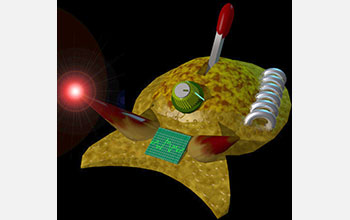Multimedia Gallery
'Cyberslug' depicted as a cyborg
"Cyberslug," depicted in this cartoon as a cyborg, is an artificially intelligent creature.
More about this image
Researchers at the University of Illinois have built an artificially intelligent ocean predator that behaves much like the original flesh-and-blood organism it was modeled after. Called "Cyberslug," the virtual creature reacts to food and responds to members of its own kind much like the actual animal -- the sea slug Pleurobranchaea californica -- does.
The researchers gave Cyberslug simple self-awareness. "That is, it relates its motivation and memories to its perception of the external world, and it reacts to information on the basis of how that information makes it feel," said Rhanor Gillette, a molecular and integrative physiology professor at the university.
Cyberslug also knows when it’s hungry and has learned which other kinds of virtual sea slugs are yummy to eat and which are less desirable.
When sea slugs encounter another creature in the wild, they will typically choose one of three responses: eat it, mate with it or flee. To make the correct decision, they must be able sense their own internal state (Am I hungry?), get cues from their environment (How does it smell?) and remember past encounters (Did this thing sting me the last time?).
Gillette said their typical response is avoidance, but hunger, sensation and learning together form their "appetitive state" and, if high enough, the sea slug will attack.
"When P. californica is super hungry, it will even attack a painful stimulus," he said. "And when the animal is not hungry, it usually will avoid even an appetitive stimulus. This is a cost benefit decision."
This research was supported by National Science Foundation grant IOB 0447358.
Read more about this research in the NSF News From the Field story Virtual predator is self-aware, behaves like living counterpart. (Date image taken: around 2010; date originally posted to NSF Multimedia Gallery: June 11, 2018)
Credit: Graphic by Mikhail Voloshin
Images and other media in the National Science Foundation Multimedia Gallery are available for use in print and electronic material by NSF employees, members of the media, university staff, teachers and the general public. All media in the gallery are intended for personal, educational and nonprofit/non-commercial use only.
Images credited to the National Science Foundation, a federal agency, are in the public domain. The images were created by employees of the United States Government as part of their official duties or prepared by contractors as "works for hire" for NSF. You may freely use NSF-credited images and, at your discretion, credit NSF with a "Courtesy: National Science Foundation" notation.
Additional information about general usage can be found in Conditions.
Also Available:
Download the high-resolution JPG version of the image. (419.1 KB)
Use your mouse to right-click (Mac users may need to Ctrl-click) the link above and choose the option that will save the file or target to your computer.

